

A tale of two Walts

When it comes to famous Walts in the world, movie lovers have Walt Disney, bookworms have Walt Whitman, and basketball fans have Walt Frazier. Drag racing recently lost two of its favorite Walts, Walt Austin and Walt Stevens, within a month over September and October, all this just a few months after losing Walt Rhoades in March.
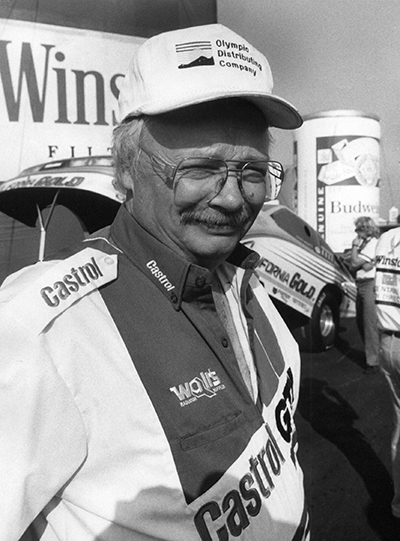
Although most modern race fans know Walt Austin, who passed away Sept. 18 from cancer at age 84, as the architect behind the overwhelming success of his son, Pat, in both Top Alcohol Funny Car – where he won four world championships – and in Top Fuel, Walt actually was a pretty big deal in Top Gas back in the 1960s, when his cars won hundreds of Top Gas events, primarily with Richard Rogers behind the wheel but also with Dave Jeffers and Dave Grassi at times.
Together Austin and Rogers turned the first seven-second AA/GD elapsed time (7.87 at the 1967 Winternationals) and were the first official NHRA AA/GD Dragster seven-second record Holder (7.92) and were two-time Division 6 Top Gas champions.
Before his Top Gas success, Walt also had the Northwest’s first blown Funny Car, the Austin & Grassi Nitro 'Cuda, which was undefeated in match race competition in 1967 and driven by both Grassi and Rogers.
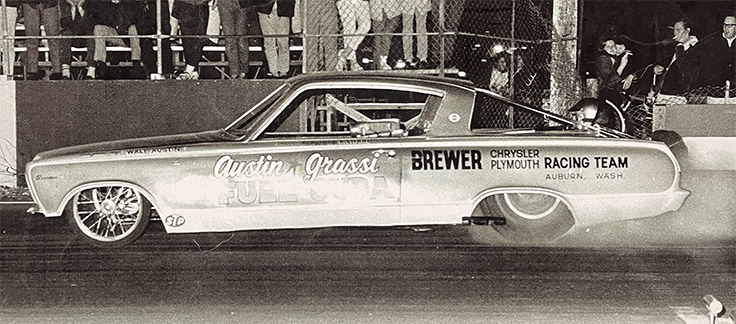
Son Pat remembers, “They were booked into a match race in Edmonton against Dale Armstrong, and everybody hated my dad’s 'Cuda because, compared to the Funny Cars back in the day, it was a real Funny Car. It was a front-engined car with a chassis. It was only 115 inches or something, so it kind of was a revolutionary deal. But anyway, they went up to Canada to match race, and they had over 20,000 people in the stands, and they beat the Canuck three rounds in a row and fans started throwing beer bottles at them.”
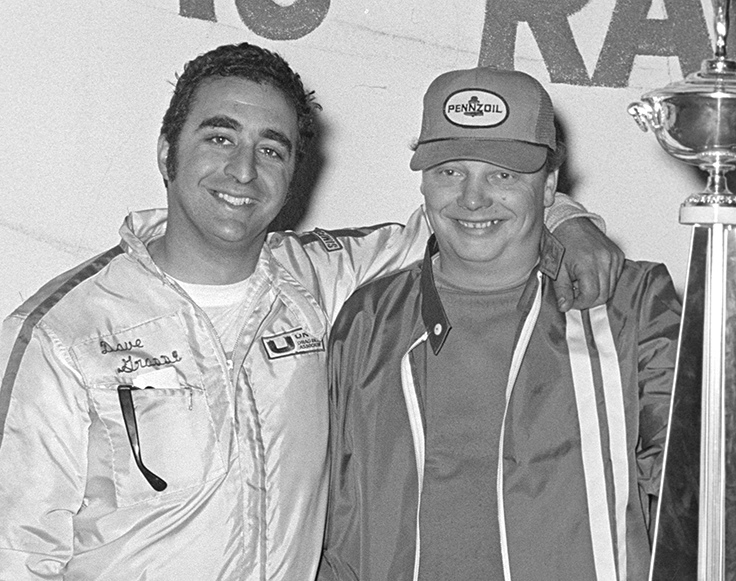
After he briefly stopped running his own cars to focus on taking over his father’s business after his passing, Walt built the engine and tuned Grassi to the Top Gas victory at the 1969 Winternationals, the same year he won the Wynn’s Oil Top Mechanic Award.
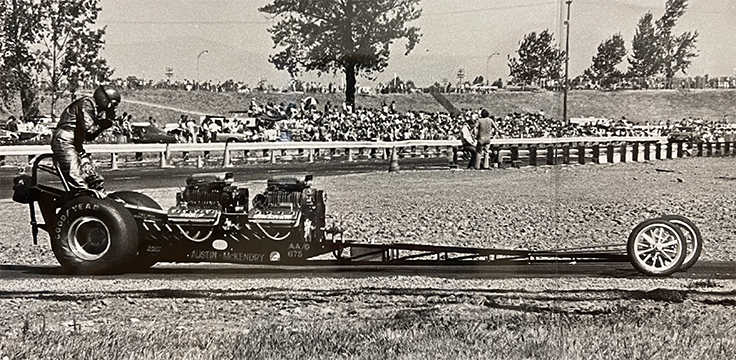
With Rogers at the wheel of Walt’s two-engined dragster in 1971, they set the NHRA AA/GD speed record at 206.42 mph in Seattle, a record that still stands today 43 years later because the class was dismantled at the end of 1971.
Walt stopped racing in the 1970s to spend time with his sons, Pat and Mike, and helped coach them in football and baseball.
“He was a helluva coach,” said Pat. “In football, I think we lost one game over five years, and we did that all through junior high and high school. When I was a senior in high school, I think he got bored and bought Richard Rogers’ old Funny Car stuff and started out with Bob Gage driving.
“I was really into working on cars – had been since junior high – and I started working on the car with him, and then he bought another Funny Car from Mike Miller, and I asked him, ‘If I put that car together, would you let me get my license?' and he said yes. I’d already been driving a rear-engined dragster in bracket races and had won a few races, so me and some biddies put it together, and I got my Alcohol Funny Car license. This would be in 1985.
“We raced with Bob for a while, which was a good learning experience because he had a lot of experience, and then my dad decided to put me in the car, and then away we went. Two months later, me and my brother were in a Chevy pickup towing all the way back to Baton Rouge [La.] because my dad wanted to go to that race. We didn't qualify, but the whole experience started there.”
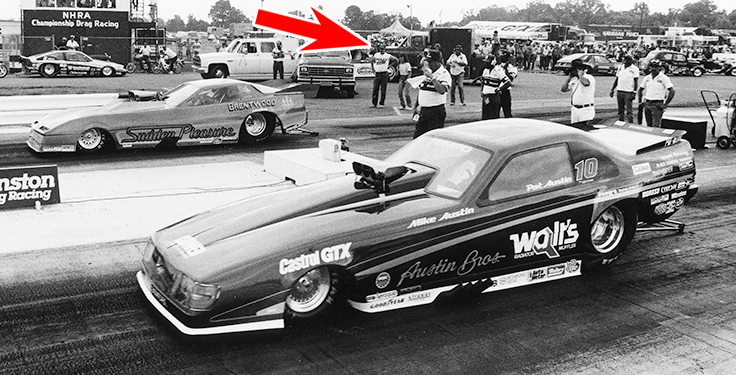
A year later, back in Baton Rouge, the team won its first of what would be 75 NHRA national event titles, defeating Dal Denton in the final round. (Denton’s guest crewmember at that race? Me! I was working on a story on Denton and worked on their car at the event. That arrow points at little ol’ me.)
They also won the Springnationals that year but finished second in points behind Frank Manzo, which was a really crucial time for the team.
“When we lost the championship by two points to Manzo, that really pissed us off. Frank was a very experienced driver, and Brad Anderson and all those guys were badass, and here we are, and we didn’t even has a [data logger] on our car. Once we put one on, we found out that I was shifting way too early – about 7,000 rpm instead of 9,200 – and the minute I started revving it up, we started running 6.30s like Brad and Manzo were running.”
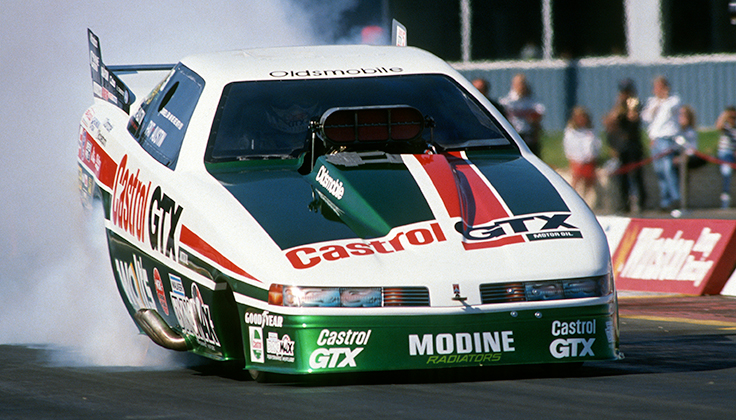
From there, the runaway freight train that was Walt Austin Racing and Pat Austin really took off then, and as part of the six-car/six-class Castrol GTX “superteam” in 1987 – with Gary Ormsby, John Force, David Nickens, Bill Barney, and Dave Boertman – won six more races and the first of four world championships.
Pat unabashedly says he knew he had a winning gene in him.
“Any kind of competition – no matter whether it's football or driving a race car or hitting a baseball or singing in the choir – man, it's a competition, and that's what really gets me going,” he said. “But all of that hinged around my dad's competitiveness and his knowledge. Not winning was not an option most of the time, and he was really good at tuning that race car.

From left, Alan Johnson, Pat Austin, Blaine Johnson, and Walt Austin
“My dad was big into having the best parts available and, now, because of the higher engine rpm, he wanted a better cylinder head. We worked some with Dick Maskin and then we got hooked up with Alan Johnson, and Alan just kept advancing it with better-flowing heads and making them better and better and better. And my dad was really big into the blower industry — he knew Art Whipple from back when he was running Funny Cars with Ed McCulloch — and that led to the PSI and Whipplecharger blowers that everyone was running.
“That first Whipple blower was pretty tall and heavy, so he thought we should mount it down in front of the motor and had Steve Leach do the engineering, and we were almost ready when we get a phone call from NHRA saying, ‘We can't allow that.’ We had to abort the project, but that's the kind of mindset he had. His mind was always on development and how to make a better mousetrap.”
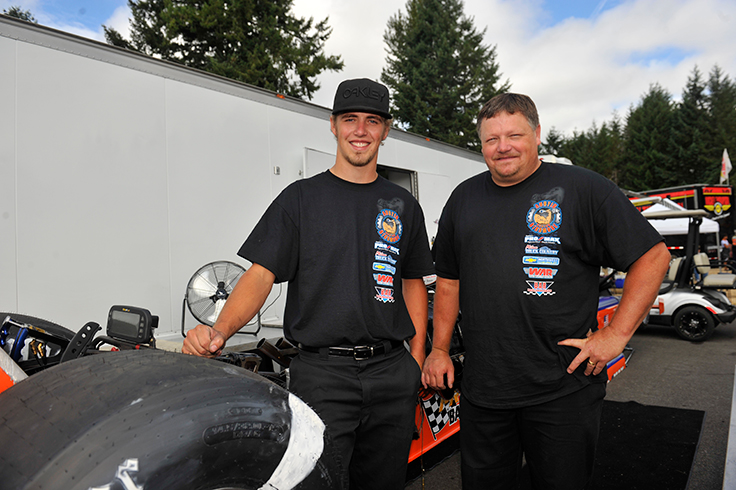
Drew and Pat Austin
Walt’s other grand idea was a Ford-based Top Alcohol engine that he developed with John Rodeck that had a 4.900 bore center compared to the 4.840 of the traditional Chrysler-based blocks. NHRA also nixed that idea, and it was regrettably shelved, but the block finally found its way into the Austin family’s car 20 years later when Pat’s son, Drew, began racing in the NHRA Hot Rod Heritage Racing Series.
The Austin family’s Castrol GTX Olds Top Alcohol Funny Car won world championships again in 1988 and ’90 and had won 45 times between the 1986 Cajun Nationals and the 1991 Northwest Nationals in their Seattle backyard.

It was during the 1991 season that Ormsby was battling terminal stomach cancer, and when he passed, Castrol team boss John Gardella asked the Austins if they would take over running the Top Fuel team with its current squad, which included crew chief Lee Beard and, among the crew, future world champion crew chief Dickie Venables.
Walt bought the Top Fuel team, and Pat effortlessly licensed in the car with 5.0s runs in Seattle, and the team brought the car to the world’s biggest drag race, the U.S. Nationals. Running both the Alcohol Funny Car and Top Fueler, Pat incredibly reached both final rounds. He had stunned everyone during Top Fuel qualifying with near-perfect reaction times and was actually a bit of a favorite to beat Kenny Bernstein in the Top Fuel final, which came not long after Pat had won the Alcohol Funny Car race title. But things went wrong on the burnout.
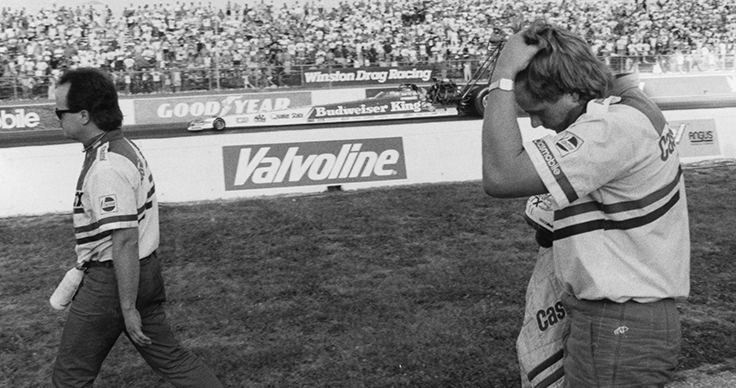
The tires grabbed unexpectedly, and the nitro newbie tried to continue the burnout, but the blower backfired and that was that. He had to disconsolately watch Bernstein smoke the tires on his final-round solo, but weeks later, he won in both classes at the NHRA national event in Topeka to become the first driver to win in two classes at the same event, a feat he would repeat early the next season in Phoenix.

Pat would win five times in Top Fuel with a variety of crew chiefs over three seasons before the difficulty of funding and running two teams got to them, and they returned to only running the Alcohol Funny Car, and they won 19 more times with Pat’s 75th and final victory coming at the 2002 Winternationals. He was just the second driver to reach 75 wins, behind only Bob Glidden.
Although he was probably plenty capable, Walt didn’t want anything to do with tuning the Top Fueler, but tuned Pat for all 70 of his Top Alcohol Funny Car wins, even when Pat was probably capable of doing it himself.
“I learned a lot through the years, and we didn't agree all the time, but he was the boss, and he's the one that got the results,” Pat reasoned. “We didn't get along all the time because of our competitive nature – everybody wants to win, nobody wants to lose – but he’s the one who made all the decisions, everything, and we just enacted his playbook and how he wanted things done. How can you bitch about that? He was the guiding light. He was the one making the car run, he was the one paying all the bills, and he was our leader. He was the coach of the team.
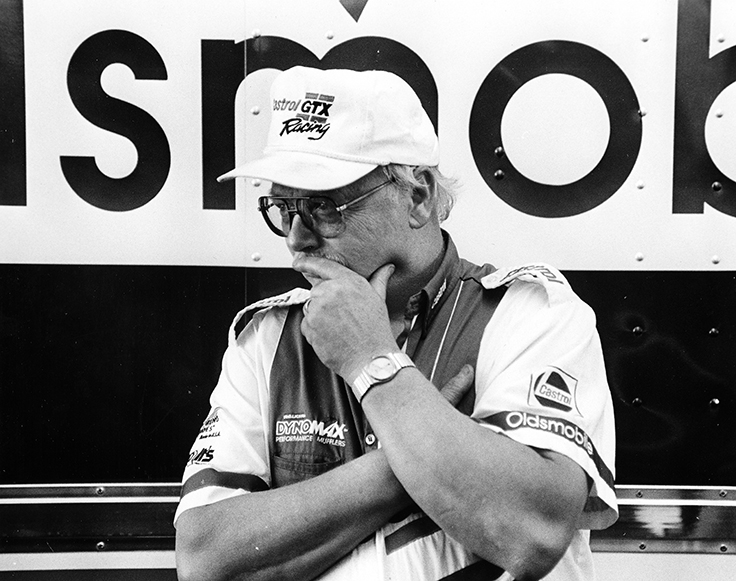
"My dad had a lot of pride, and he loved it, and when he got hot, when we started figuring it out and everything came together with his new cylinder heads and blowers and stuff, he knew exactly what he was doing, and we won a lot of races over a short period [including 34 between 1988-92 alone] and just had a great time, and the fact that he did it with me and my brother meant a lot to him.
“I got to spend some time with him when he got sick, and we had a lot of time to talk, sitting in hospitals during his chemo treatments because I went to every one of them with him through the four years, and we had a lot of time to reflect on how good we did and how much fun we had. There's lots of good drivers that didn't have good cars, and there's lots of good cars that didn't have good drivers, and we were lucky we had a combination of both.
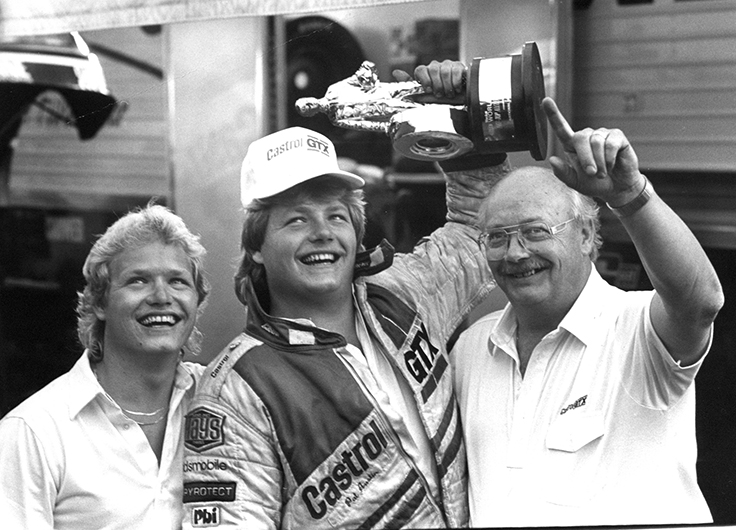
“Of all the wins, Indy wins, championships, whatever, the wins that meant the most to him were the Allstars wins we had in 1987, ’88, and ’89, because they were always on Father’s Day weekend, and me and my brother would always present him the trophy and say, ‘Happy Father's Day,’ and he actually started crying, so that was a really cool memory.”
After seeing his son become a multitime world champ, Walt also got to see his grandson, Drew, win two A/Fuel championships in NHRA’s Hot Rod Heritage Series and then step into the family’s Nostalgia Funny Car, all with the Ford engine he developed, bringing the whole family story almost full circle and ensuring that the Austin family legacy will live on and on.
Walt’s passing came just six months before he and Pat were to be honored and enshrined in the International Drag Racing Hall of Fame next March, but the accomplishments that he engineered will long be remembered.

Our other Walt, Walt Stevens, was one of the most talented and adept rail pilots of the 1960s and ‘70s Southern California racing scene, and he was well respected and admired when he died Oct. 12.
Stevens perhaps is best known as the last racer to win a Top Gas title at the Winternationals in 1971 but had a long list of accomplishments and rides on his résumé.
He holds a soft spot in my heart as a fellow graduate of Southern California’s Venice High School, a virtual wellspring of early drag racing talents that incudes names like 1960 Nationals Top Eliminator winner Leonard Harris, John Peters of Freight Train fame, and Mike Sorokin of The Surfers Top Fuel team. I wrote a whole column about this, Be True to Your School, back in 2008.
Stevens caught the racing bug early from his dad, who raced midgets, but drag racing captivated him in high school, and when they took it to the streets, he and buddy Peters both ended up with suspended driver’s licenses.
When Peters returned from a two-year hitch in the Army, he and Peters reunited in 1959 and took their four-wheeled fun to the track, where they raced together until 1964, at which point Stevens joined another Venice alum, Frank Hedge, to drive the famed A&W Root Beer Top Fueler.
“I went 184 mph on my first time out at Lions Drag Strip,” he told NHRA National Dragster in 2002. “From then on, I was hooked."
Stevens’ stay lasted about as long as a large root beer float as by year’s end he was driving Dick Stahl's' A/Fuel Roadster, which was powered by a rare Mickey Thompson Hemi Ford that ended up next between the framerails of a Kent Fuller dragster chassis in Top Fuel.
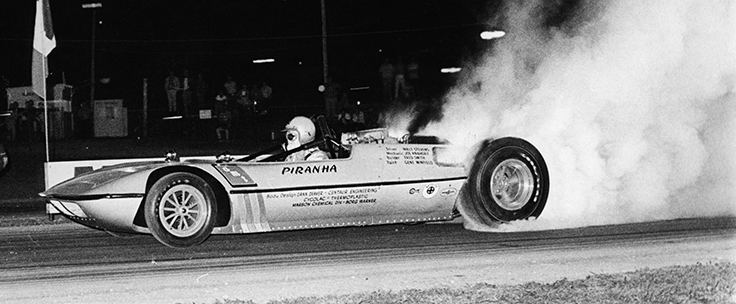
In 1966, Stevens took over the wheel of a strange little hybrid, the AMT Piranha, a rear-engined plastics showcase of a wedge Top Fueler.
"The AMT model company needed a tax write-off at the time," said Stevens, "and they also wanted to promote the strength of the new ABS plastic, so the Piranha was developed to meet both needs. I match raced against drivers like Don Nicholson, Gas Ronda, and Doug Thorley, and against Don Garlits' dragster with a Dart roadster Funny Car body. We traveled all over the country that year."
Connie Swingle and Don Cook took over the Piranha in 1967, and Stevens went to work at Frank Huzar's Race Car Specialties chassis shop, during which time he also drove Jim Hoskinson's The Trip car, which had been purchased from the Surfers' Tom Jobe.
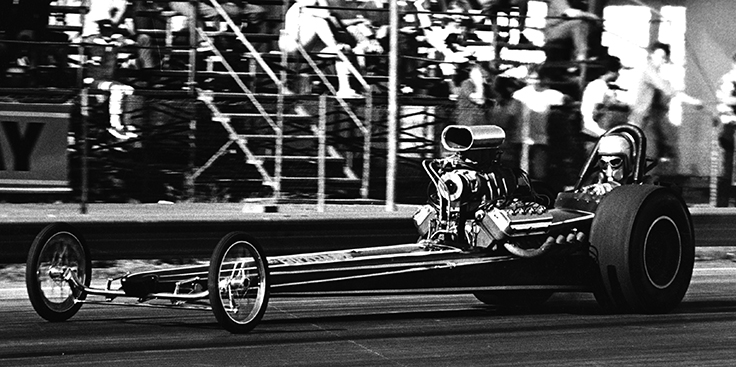
"That was during the Flower Power summer of 1967, so we gave the car a psychedelic paint job and called it The Trip," said Stevens. “The engine was set too far back, and it was wheelstand prone, so we built a new car at Frank's shop in one week and ran it another six weeks before selling it to Chuck Stevens [no relation], with whom collaborated on the Gaslite dragster in which he won a Top Gas race at Orange County Int'l Raceway his first time out, defeating a field that included Bob Muravez, John Rasmussen, and Mike Snively, among others."
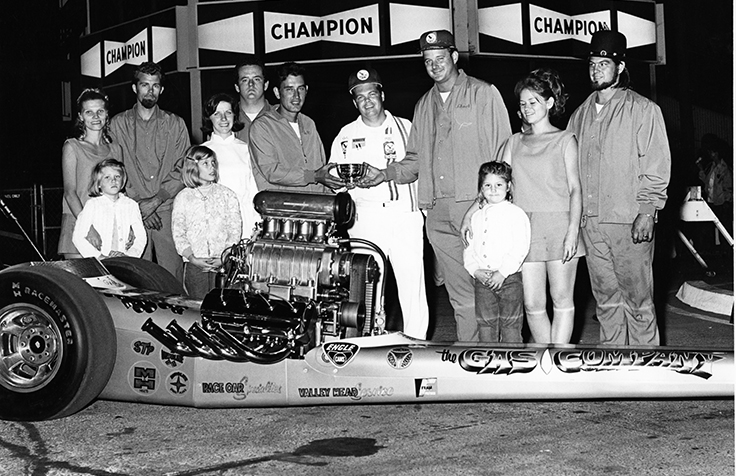
Stevens returned to Top Fuel with John Raviart's Outcast entry, but the sledding was tough against some of the best in the country, including the Warren & Coburn Ridge Route Terrors.
Recalled Sevens, "We raced James Warren once at Irwindale Raceway, and I ran 226 mph after getting a jump on him at the starting line, but he went by me like I was standing still. The clocks said that he went 245 mph. It was such an unbelievable number at the time that he wasn't credited with the run. As far as I’m concerned, he went more than 250 mph."

Stevens' last full-time ride, in Ken Theiss' famed Odd Couple car, was among his best. Future Top Fuel world champ Kelly Brown had been driving the car but also had a ride in Leland Kolb's Top Fuel car and couldn't do both, so Stevens got the ride.
The twin-engined car was so named because it ran a small-block Chevy up front tied to a Chrysler.
“When I fired up the car, I always started the Chevy engine first because you couldn't hear anything else after the Chrysler motor was running,” he said. “It actually became a pretty potent combination. Once, we tried running two Chryslers, but the car ran out of gear before the finish line."
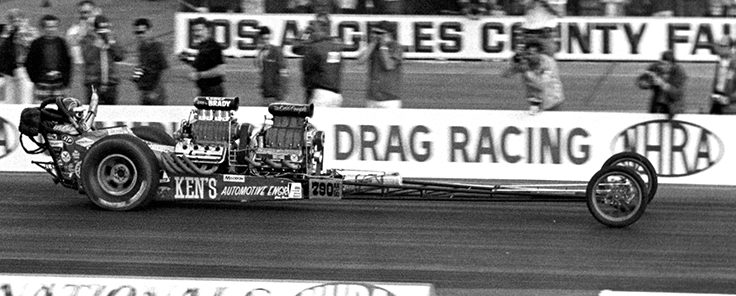
Stevens' victory at the 1971 Winternationals came on a final-round bye run after opponent Bill Mullins couldn’t fire because of a broken crankshaft. The late, great NHRA Starter, Buster Couch, gave Stevens the go-ahead to make a bye run in the final, but not before shaking Stevens' hand in congratulations.
"I’ll always remember that moment," said Stevens. "When I heard that Buster had died, that was the first thing I thought of."
Weeks later, Stevens also won the famed Bakersfield March Meet, beating Ken Moitoza in the final.
“At about halftrack, I noticed that Moitoza was slightly ahead of me," said Stevens, "and our Chrysler engine started to come apart. I actually ducked my head down but kept my foot in it. When the smoke had cleared, a piston was in my lap and Ken was still in front of me, but when my crew came honking down the return road, I realized that I had won. I must have surged ahead as we crossed the finish line when l couldn’t see."
After Top Gas ended in 1971, Stevens drove Jack McCloud’s Top Fuel car for six months before retiring from racing.
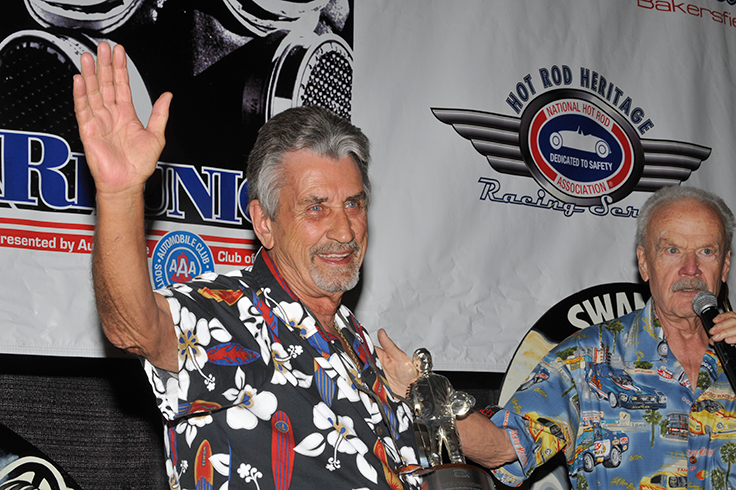
Twenty-plus years later, Stevens began racing on the Nostalgia Top Fuel circuit in 1994 at the suggestion of Hedges and tuned Bill Alexander in the Master Cam car, which was later driven by the likes of Tim Gibson, Sean Bellemeur, Mike Boyd, Mendy Fry, and Troy Green.
Two Walts, gone too soon, but careers that will forever be remembered by those who witnessed their achievements.
Phil Burgess can be reached at pburgess@nhra.com
Hundreds of more articles like this can be found in the DRAGSTER INSIDER COLUMN ARCHIVE
Or try the Random Dragster Insider story generator




















































